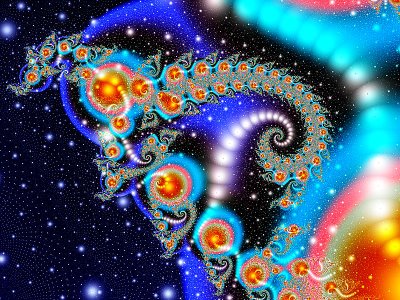
O padrão gráfico dominante na criação de fractais é a forma da espiral.
Matematicamente a espiral é uma curva que gira em torno de um ponto central, afastando-se ou aproximando-se deste ponto, dependendo do sentido em que se percorre a mesma curva.
Para melhor compreendermos este fenômeno, devemos ficar atentos à geometria da Natureza, que, no caso do Universo, vai determinar a diversidade de espirais como podemos observar nesses exemplos de galáxias.
Mas é claro que para entender sistemas tão complexos e dinâmicos como as galáxias, precisamos compreender o que determina a Teoria do Caos.
E devemos também dar uma estudada básica sobre a construção matemática dos fractais.
Agora que todas as coisas estão verdadeiramente confusas, você está pronto para começar a criar as suas espirais. Eu particularmente não me sinto atraído por sua forma. Esteticamente elas são previsíveis e esta característica as torna um tanto irritantes para mim. Raramente me dedico a produzir espirais. Entretando reconheço que a qualidade evocativa da espiral deve-se a que podemos identificar nela alguns aspectos do "mistério da vida", ou seja, algo que julgamos poder atribuir à nossa própria existência e à de todos os seres vivos - o eterno recomeço ou a volta para si mesmo e a perpetuação da existência.
Creio que todas as civilizações encontraram na forma da espiral a representação do devir do homem sobre o mundo. Isso talvez tenha contribuido para que elas sejam tão atraentes. Através da espiral julgamos poder desvendar uma parte desse mistério que nos assombra e que tentamos prefigurar na sua rota ordenada e que se mantém "intocada" pelo caos que a rodeia. Existe melhor maneira para figurar a "intenção" de nossa existência individual?
Comments